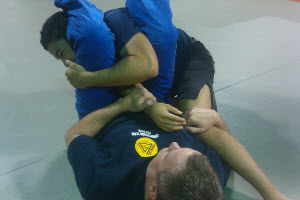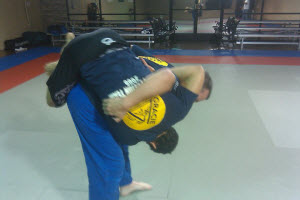 It’s difficult to spend any time researching self-preservation topics, especially on the internet, without stumbling over someone warning, “Don’t go to the ground in a street fight.” The implication seems to be that even touching the ground with anything other than the soles of your feet will result in instant death.
But as with many instances of keyboard commando advice, there are some things missing from the overall thought process, and I’d like to address them. Hopefully, this article will cause people to re-examine certain beliefs. Let me be clear that I am not going to advocate a specific tactic. Rather, I am going to see if the logic behind the rationale stands up to the light of reason.
Let’s address the cliché itself. Rather than saying “Don’t go to the ground,” why don’t we say, “Don’t get into a fight” instead? After all, that would solve all our problems. “But Cecil,” you say, “it’s impossible to always avoid the fight. We have to be ready for the unforeseen.” Exactly! Of course it would be stupid to tell someone simply to not get into a fight. Yet that is no different from the cliché that headlines this article. It’s just as thoughtless. The mere fact that you don’t want to go to the ground does not mean you will not find yourself there regardless. Spouting that cliché accomplishes nothing and leaves someone woefully unprepared for the reality of the street.
It’s difficult to spend any time researching self-preservation topics, especially on the internet, without stumbling over someone warning, “Don’t go to the ground in a street fight.” The implication seems to be that even touching the ground with anything other than the soles of your feet will result in instant death.
But as with many instances of keyboard commando advice, there are some things missing from the overall thought process, and I’d like to address them. Hopefully, this article will cause people to re-examine certain beliefs. Let me be clear that I am not going to advocate a specific tactic. Rather, I am going to see if the logic behind the rationale stands up to the light of reason.
Let’s address the cliché itself. Rather than saying “Don’t go to the ground,” why don’t we say, “Don’t get into a fight” instead? After all, that would solve all our problems. “But Cecil,” you say, “it’s impossible to always avoid the fight. We have to be ready for the unforeseen.” Exactly! Of course it would be stupid to tell someone simply to not get into a fight. Yet that is no different from the cliché that headlines this article. It’s just as thoughtless. The mere fact that you don’t want to go to the ground does not mean you will not find yourself there regardless. Spouting that cliché accomplishes nothing and leaves someone woefully unprepared for the reality of the street.
Typical Excuses: Injury
What are the typical excuses given as reasons why we should not go to the ground? First there is the idea that in the real world, we are not on soft mats and therefore will suffer immense injury on hard surfaces like concrete and asphalt. Except that the reality rarely, if ever, matches up to the cliché. A good grappler has spent a great deal of time learning how to fall with minimal injury as a routine part of training. And if anyone thinks that standard judo mats are “soft,” they are mistaken. There is not that much padding.
A few years ago, on an episode of the TV show The Ultimate Fighter, there was a scene where two of the participants got into a fight in the backyard of their house. One fighter locked in a triangle choke. The other person, in an attempt to break free, managed to pick up the choker far enough that he dropped him, spine first, on the raised brick edge of a fire pit. Guess what happened? Nothing! The first guy was unfazed and kept fighting. Even though his spine was slammed onto an edge of unbending concrete, he was able to shrug it off with no effect. This was no anomaly. It is a simple by-product of basic training and experience.
Toxic Ground Surface
Critics will also talk about how you don’t want to roll around on the ground where there is broken glass, used syringes, razor blades, feces, rocks, and on and on. First of all, where are they hanging out? Granted, there very well could be bad stuff on the ground, but critics talk as if that is everywhere! I have been to some very bad and rundown places in my life, and I can count on both hands with fingers left over the number of times I saw gross conditions. Should we base our tactics on literally .001% of possibilities? That seems more than extreme to me.
As far as rocks or uneven surface, I am here to tell you that is utterly irrelevant. I recently conducted two blocks of instruction at the Mid-Atlantic Tactical Conference on Brazilian Jiu-jitsu (BJJ). I taught in an open field, with uneven ground, large and small rocks, wolf spiders, and sundry other obstacles. Not one person had a problem doing any of the material. What’s more, almost all of the participants were complete beginners to grappling. Yet there were no hitches whatsoever. Like falling on hard surfaces, bad terrain is blown so far out of proportion that it is more revealing of those who talk about it.

A standard grappling position that puts the top man in perfect position to completely control the bottom person’s actions, including denying the weapon draw.
Weapons
Weapons are often given as another reason to stay on your feet. If the fight starts outside immediate grabbing range (say, outside five yards), I absolutely agree you should not give up mobility by going to the ground. However, if the fight starts within that five yards, or the distance closes to that quickly, taking the fight down might be a good idea. After all, standing up, your opponent has three dimensions of space to move in while trying to deploy and use his weapon. On the ground, you can use the surface in your favor to take away some of his movement, perhaps pinning his arms or the weapon itself. That is a viable tactic impossible to do standing.
Multiple Opponents
The threat of multiple opponents is regularly used as well. I would argue that against multiple opponents, you are much more likely to go to the ground. It only takes a few rounds of force-on-force training to realize that even when you have room to move, all it takes is one hand to grab on and then you’re easy prey for the others to pull down. Knowing how to maneuver in the best and most efficient manner seems like a pretty good idea to me.
This leads to another critique by grappling opponents. They will say that while you are occupied rolling around with one attacker trying to use a submission, his friends can come up and start kicking you in the head. Let’s leave out the possibility that I might have friends of my own watching my back to prevent that, and focus on the idea that I will be fair game for that kicking. This is a pretty big misconception that arises because those critics don’t have experience on the ground and are relying only on what they see in MMA fights in the UFC, or on YouTube watching two high-level black belts competing in a sporting competition.
What they fail to understand is that those examples are between two evenly matched, trained opponents. Of course those fights might go on and on with no resolution. But that has little bearing on a street scenario between a skilled BJJ exponent and an attacker with no knowledge of the ground fight. In that case, the fight won’t be a long, drawn-out affair. It is more likely to take only seconds, ending with a quickly applied choke or joint break. This is not hyperbole, it is fact.

Bottom person holding guard now has immense control. He can snap the arm, sweep the other guy over, or quickly transition to a triangle choke, all within seconds.
The simple fact is that you had better know what to do to survive in a grappling situation, and that doesn’t mean relying on “foul tactics” or a weapon to get you out of that hole. It means learning proven functional strategies, honed in battle and on the mat for centuries. It means you need to be an open book, willing to put in effort with an experienced instructor and to practice those skills learned.
As stated earlier, I am not advocating going to the ground as the answer in every situation. But neither should someone say, “never go to the ground.” Both are dangerous. Combat is too chaotic and there are too many variables to have a dogmatic, knee-jerk response. Let’s look at the totality of combat and make our training choices with logic and thoughtfulness.



Share tips, start a discussion or ask one of our experts or other students a question.
Already a member? Sign in
No Responses to “Don’t Go to the Ground!”